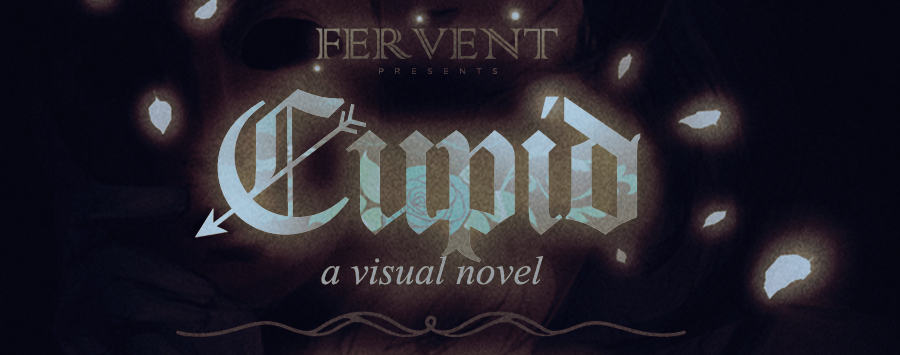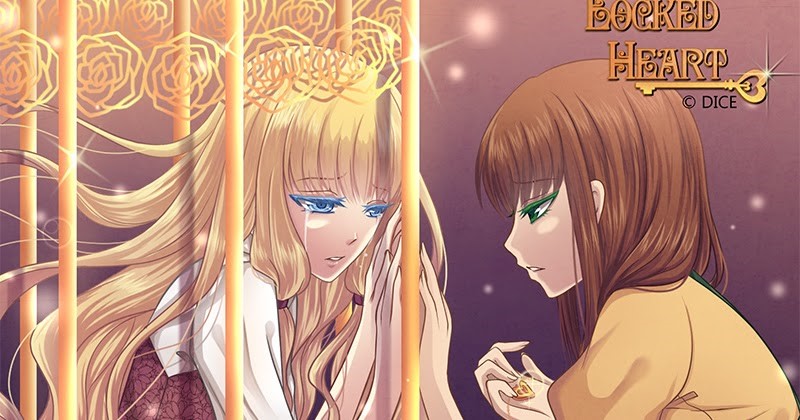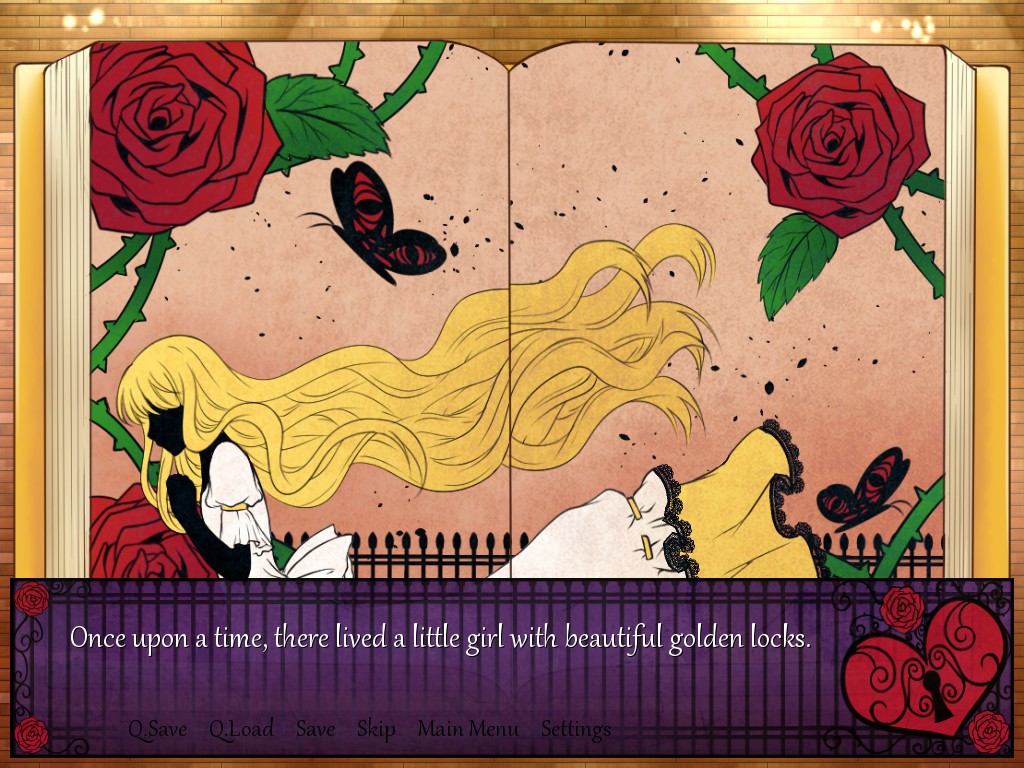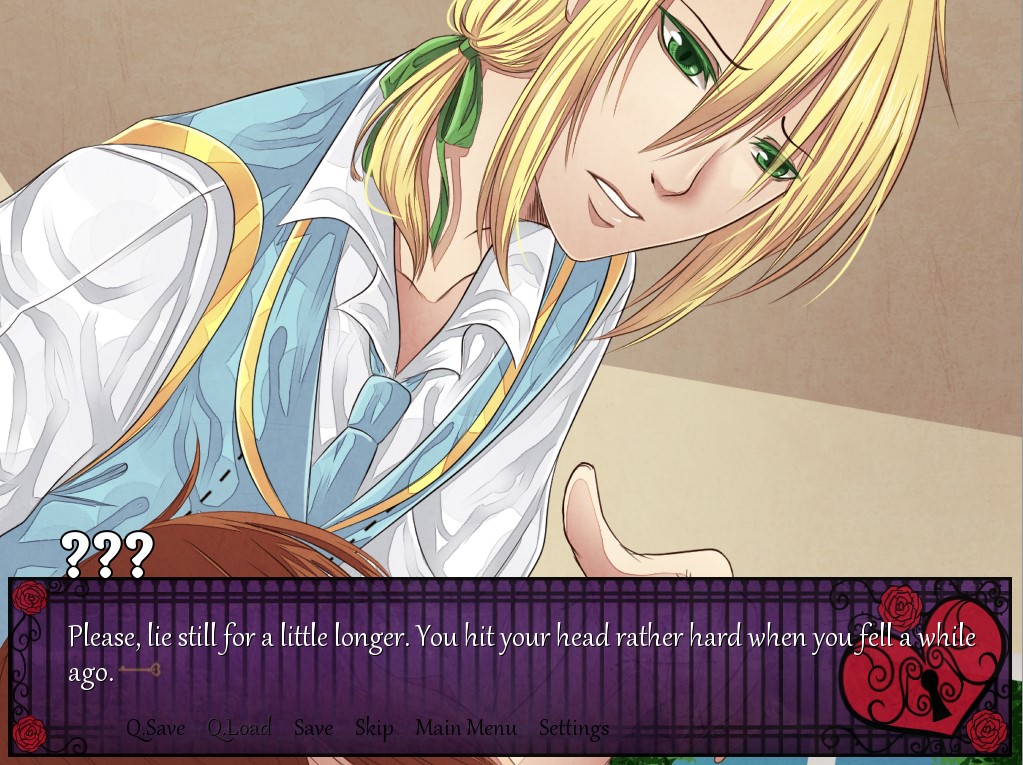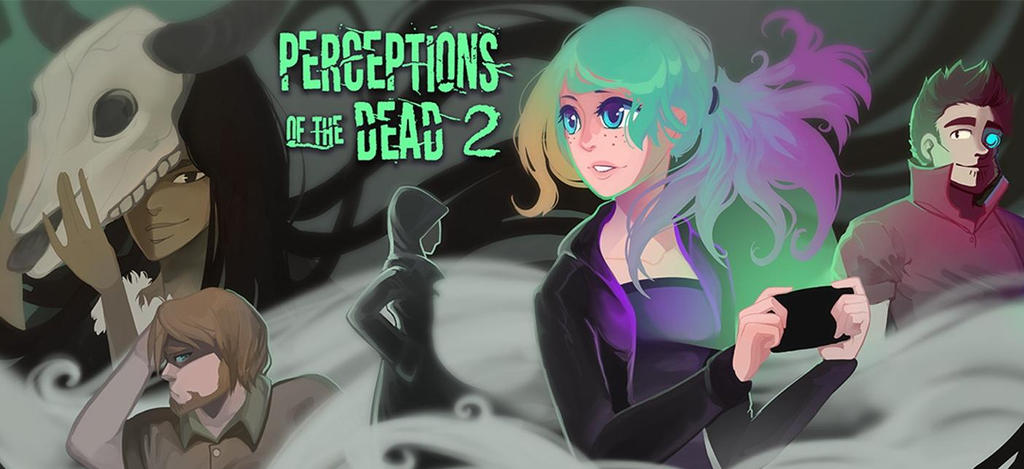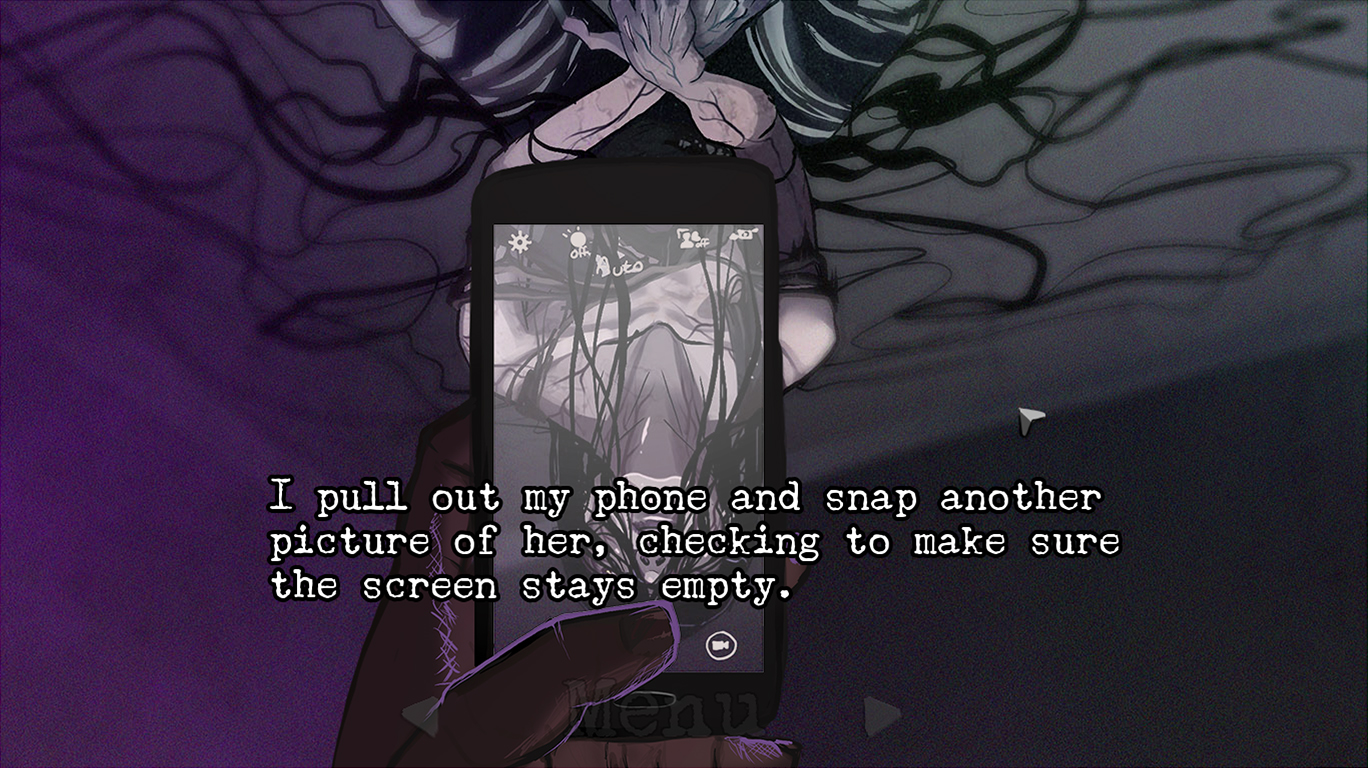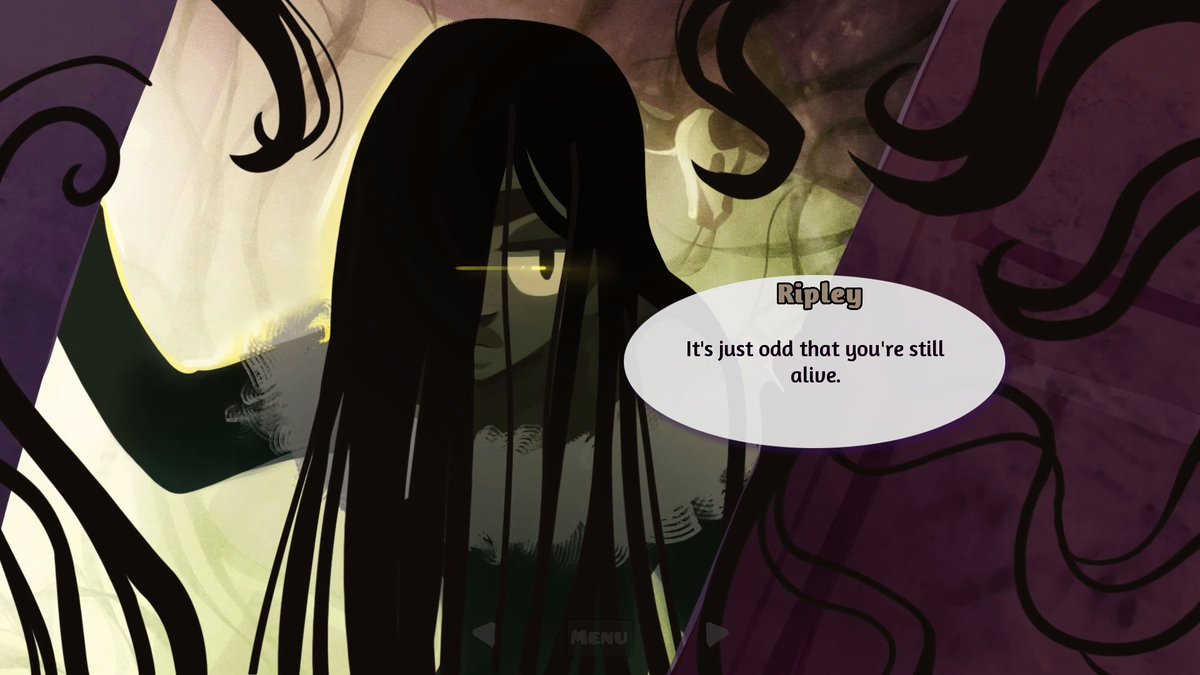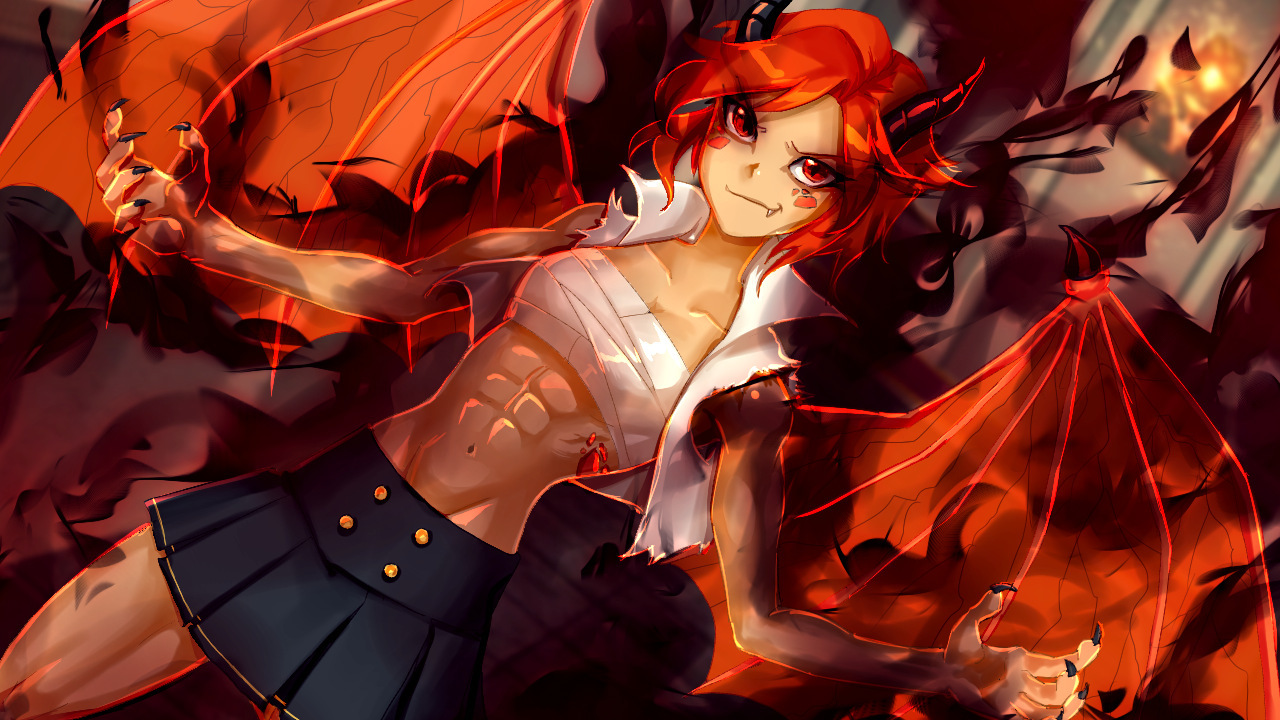
Zetsubou, a developer and writer involved in many popular EVN titles is someone whose work many fans of the genre might be very familiar with, but not necessarily even knowing about it. While have made a few relatively successful projects of his own, such as Sickness or Tomboys Need Love Too!, many of his commissioned works, such as Razzart’s Love Ribbon gained even more recognition. For this reason, among others, there was relatively little fanfare around the release of his latest project, Sable’s Grimoire, in May this year. However, there are many reasons to consider this project as a particularly notable one – the 350k-words-long, modern-fantasy tale about a young mage entering an academy filled with demi-humans is rather far-detached from the usual EVN formula, both by its scale and its dominant themes.
Of course, scale by itself does not have to be a positive, just as unusual story elements don't automatically make a VN interesting to read. Does Zetsubou's largest project to date have other merits beyond its impressive word-count and interesting premise, and does its overall quality justify the 25+ hours time investment that is required to fully read through it? In my opinion, answer to all these questions is: yes.
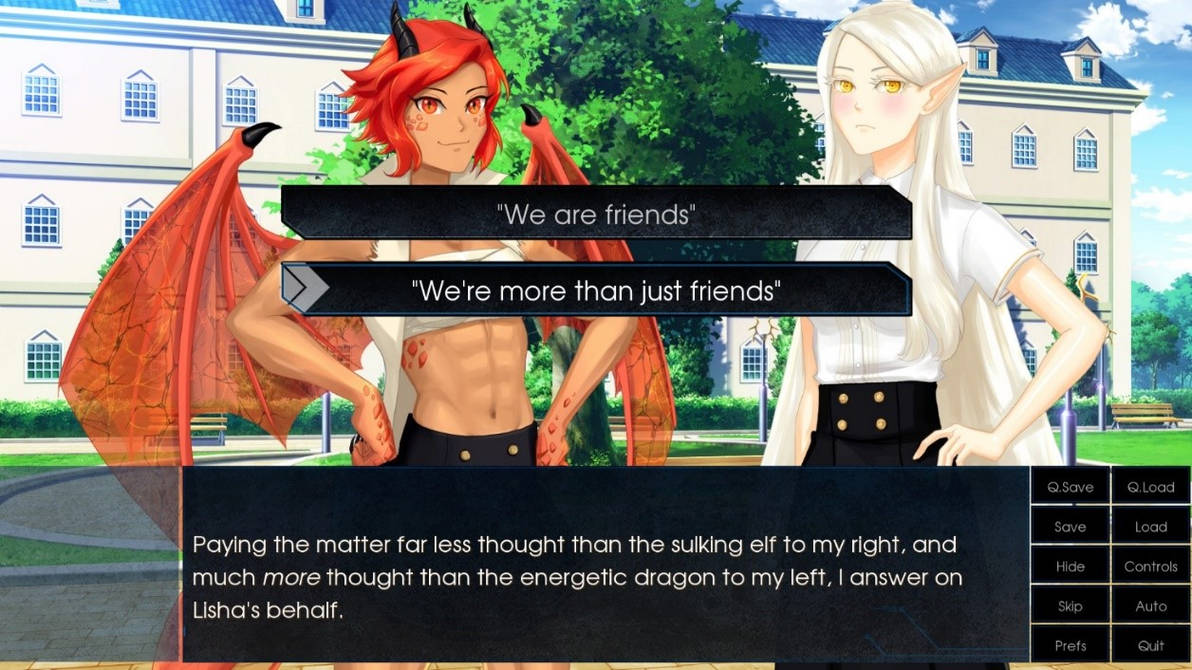
Of course, scale by itself does not have to be a positive, just as unusual story elements don't automatically make a VN interesting to read. Does Zetsubou's largest project to date have other merits beyond its impressive word-count and interesting premise, and does its overall quality justify the 25+ hours time investment that is required to fully read through it? In my opinion, answer to all these questions is: yes.

Just as the heroines are varied when it goes to personality and background, their respective routes are also wildly different from each other
Sable’s Grimoire takes some themes quite widely utilized in visual novels and combines them in a slightly unusual way. Our protagonist, Sable, is a young mage obsessed with researching magic and non-human races of the world. At the beginning of the story, he gets accepted into Amadronia Academy – a famous magic school dominated by demi-humans. There, he quickly gets disillusioned with the legendary institution, which proves quite disorderly and poorly managed, but also meets many interesting people (or rather, interesting monster girls, from a near-human rokurokubi to a frighteningly powerful half-dragon), relationships with whom will change his life dramatically.
What might be worth addressing right away is the protagonist himself, who’s not only an actual character with a face (and even one solo CG, which is pretty much unheard of when it goes to male leads in VNs), but a surprisingly consistent one at that. Driven by his thirst for knowledge and slightly unhealthy fascination with demi-humans, he’s studious and reserved, only driven into more decisive action by his ambition or curiosity. While he possesses some unique skills, some of which could even warrant classifying him as a genius, he’s also a human surrounded by creatures infinitely more powerful than him, making him reliant on his friends and allies. He’s also a deeply unromantic individual, which is an important factor in setting the tone for the most of the character routes – only three of them being vaguely romantic in nature.
Similar things can be said about the five heroines – obviously, all of them monster girls, although it’s important to point out that the game has no erotic content whatsoever and is one of the very few, if not the only example of this theme being used for something that isn’t a nukige, or borderline nukige. All the girls are well-fleshed out, with interesting traits and backstories explored in their respective routes. They also have a constant presence in the story – unlike in many other multi-route VNs, the heroines are all Sable’s friends and even after you choose one of them as your main point of interest, other ones stay as a part of his everyday life in the Academy and even get interesting episodes outside of their main story-arcs. The fact that they don’t disappear after their introduction sequences does a lot to build a strong climate for the whole story and make all the possible paths cohesive – I couldn’t catch any obvious inconsistencies when it goes to the setting and personal stories of the heroines between routes.
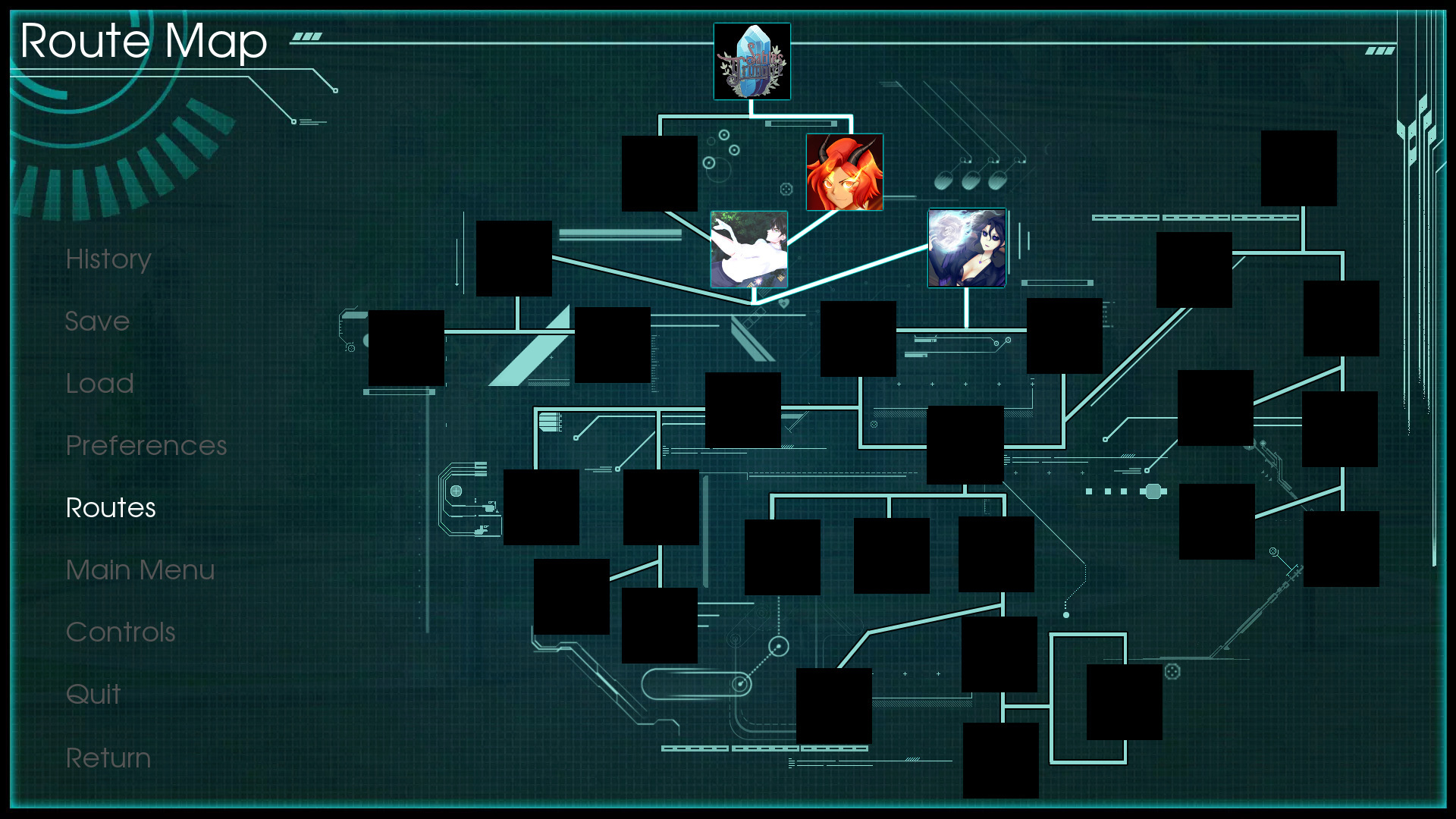
Sable’s Grimoire is not only one of the few EVNs with a proper flowchart – it’s one of the very few that actually needs one
While the main cast of Sable's Grimoire is developed in a rather praiseworthy manner, both Sable and the heroines being multi-dimensional and consistent through the story, the supporting cast also proves to be quite impressive – it’s filled with memorable characters, who not only have an important role in building the fantasy setting, but also influence the story in various ways and react to player’s actions. A good example of that is Sable’s roommate, a pixie named Tix, who might even leave the Amadronia altogether depending his choices – it signalizes to player the weight of his decisions and the fact that every path they take have its upsides and downsides, influencing protagonist’s relationships and his position in the Academy in various, significant ways. And while Tix seems to be a prime candidate on receiving her own route in the upcoming update, a few other “secondary” girls are also fleshed out well-enough to feel like appealing romance options, giving quite a lot of space for expanding the game and maybe even creating some spin-off titles.
The pretty great cast translates into some very enjoyable and varied routes. While the game has some overarching themes, such as racism and violent discrimination of non-humans, the actual story arcs differ significantly when it goes to their climate and the conclusions they lead to. Rei’s and Etch’s (rokurokubi and mandragora) joined route is mostly comedic and lighthearted, organized around the theme of friendship and has no bad endings. Jurou’s (spider girl) and Lisha’s (elf) routes, on the other hand, are very dark, featuring some highly disturbing dead ends and exploring the most unsettling parts of the game’s lore. Drakan’s (half-dragon) story emphasize adventure and, to a lesser extent, romance, giving space for some of the most spectacular moments of the game. For me, they were all fun to read, although to fully enjoy them you have to be ready to accept that characters’ flaws and backgrounds, including Sable’s personality, make for some plot developments and conclusions that strafe far from wish-fulfilment scenarios typical for more romance-oriented VNs – bitter-sweet endings and creating bonds of friendship, rather than love, are often the best that that you can hope for. The build-in flowchart makes it easy to track the various branching paths and possible endings, making it fairly easy to figure out the game without a guide, despite its size and complexity.
There are two complaints that I have to bring up at this point. The first of them is repetition and unnecessary slice-of-life filler scenes in some routes – especially in Drakan’s arc, I felt like some of the conflict and Sable’s interactions with other students didn’t really add anything interesting, neither to the story in question nor to the general world-building. There are also examples of pointless repetition throughout the game, with certain plot-points or lore details being repeatedly explained without a good reason – although, I’d interpret them as writing slip-ups that are likely to happen in a script this huge, especially when it was made basically by one person. The other problem is the relative lack of romance – counting only the optimal endings for each character, there are two friendship ones and three vaguely romantic ones, but even in case of the latter, we end up with Sable being hesitant to enter a relationship with the heroine. Also, the only route that ends up in a pretty conclusive way, that is Drakan’s, involves Sable being coerced into becoming her mate under clear threat of death – and while he might be genuinely fond of the half-dragon girl, it’s not really a heart-warming, fun scenario from any perspective. Those that are looking for a classic, romance-focused VN experience will simply not find it here.
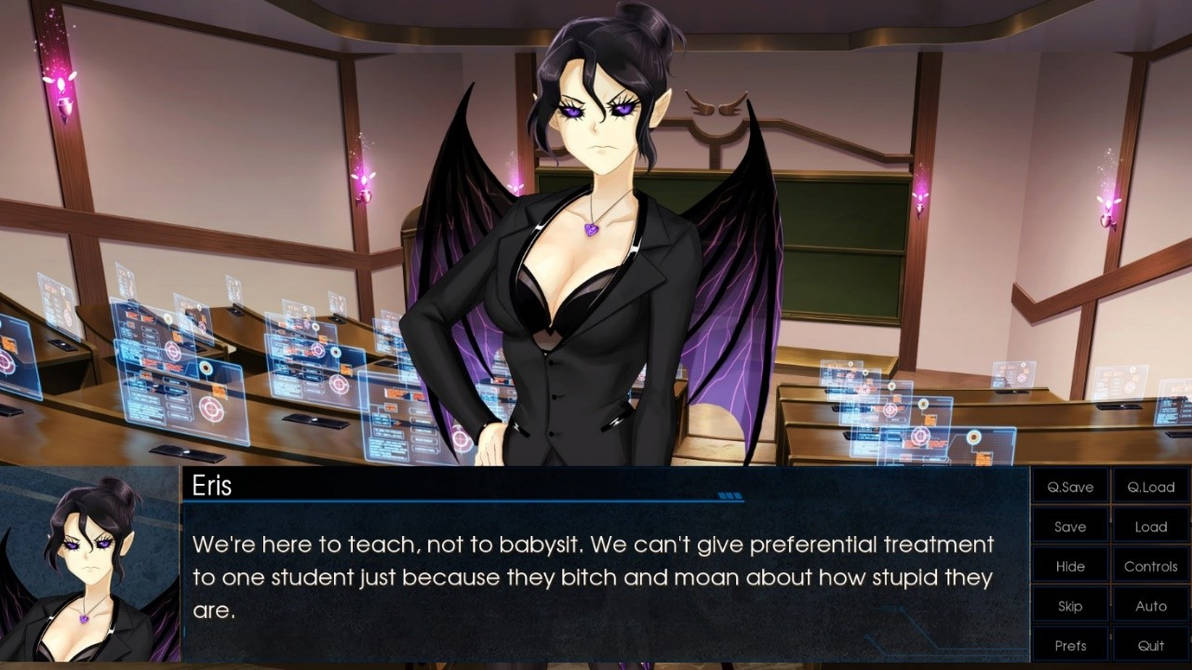

Game’s supporting cast is also one of its biggest strengths, adding to the atmosphere and depth of the story
Production values of the game are… Adequate, with most music and most visual elements being rather average, but serviceable. One thing that definitely stood out to me were the facial expressions on most sprites – those were really well-done, giving a lot of personality to the characters and communicating their emotion very well – even in the "tricky" cases such as Jurou, the heroine who always wears a mask. The CGs, while not amazing when it goes to artstyle and details, are both properly numerous (44 in total, which feels appropriate for a VN of this size) and well-utilized – they don’t only show up in crucial moments of the story or introduction sequences, but various optional scenes throughout the game, adding to its climate and giving us opportunities to explore the characters and the setting in interesting ways.
Sable’s Grimoire is a unique game, especially in the context of the Western VN market. It offers an imaginative, story-driven experience that is hard for me to compare to any other EVN I’ve played so far. While it has some obvious flaws and might not be for everyone (it’s definitely not a casual waifu game), I’ve enjoyed the nearly 30 hours I’ve spent with it immensely and can’t recommend it hard enough. Especially for the modest asking price of $15, it’s a great value proposition and one of those EVN projects that really shouldn’t go unnoticed – and I really hope it will do well enough to encourage other developers to be this ambitious and uncompromising with their work.
And before, as I hope, you rush to buy it for yourself, consider checking out my interview with Sable’s Grimoire’s author, Zetsubou, waiting for you below this review!
Final Score: 4/5
Pros:
+ Interesting, detailed setting
+ Well-fleshed-out heroines and supporting characters
+ Memorable protagonist
+ Highly distinct, enjoyable routes
Cons:
- (Sometimes) repetitious dialogue
- Lack of proper romance
- Average music and visuals
VNDB Page
Buy Sable’s Grimoire on Steam or Itch.io
----------------------------------------------------


PlkLesiak: Thank you for accepting my invitation! I’m pretty sure many of my readers recognize your nick from various EVN projects, but probably know very little about the person behind the Zetsubou label. Would you be willing to tell a bit about yourself?
Zetsubou: My games are all written in American English, but I'm actually an Australian citizen. Which isn't great, considering Australia's non-existent support of the video games industry... but I'll spare you that rant.
I'm a full-time software developer (not video games), and I've been playing visual novels since I was in high school. Since I was a kid I've always enjoyed reading, writing, and playing video games. Growing up, I generally favored RPGs, platformers and fantasy series, but nowadays my interests are much more diverse. Most of my time is spent either at work or commuting. Since I started making visual novels, that's where the majority of my free time has gone. Some people IRL know that I work on games in my free time, but to most people, I'm just that boring guy who never wants to meet up outside of work.
Plk: Before making your first independent projects, you already did commission writing for VNs. How did you get into this niche? Was writing for visual novels something you specifically aspired to?
Z: Writing is something I never thought I'd be doing to this extent. It was a hobby, something I enjoyed, but nothing more than that. As a software developer who plays video games in their spare time, branching into game development seemed like a pretty obvious transition. The big question for me was what sort of game I'd try to make.
Considering my own time and budget constraints, I realized that the most realistic paths forward were 2D RPGs, or visual novels. At that point in time, most of the VNs I'd played were translated JVNs, and I knew little about the EVN scene. I started researching EVNs, and that signalled the beginning of my foray into visual novel development. I began by helping out other people with their games while I learned how it all worked, mostly in the form of free programming.
Once I felt that I had a grasp of the basics, I started writing too. My love of story writing turned into game scriptwriting, and it quickly became my pastime of choice. It was never planned, or anything I really aspired towards. But considering my interests, VN writing made a lot of sense, and it's something I've been happy to stick with.
PLK: Sable’s Grimoire, with a 300k+ words script, is an unusually big project for a Western-produced VN. Did you plan it to be on this scale from the beginning?
Z: Not quite. I was originally aiming for something around half of the final length. But as I started writing and the cast/branching grew, SG just kept on getting bigger. There are many things about SG which changed from the concept/planning stage to its actual production. Once I started writing, the story took on a life of its own, and it quickly turned into something much bigger and broader than what I had intended to make.

Sickness
PLK: Is an EVN this big economically viable? I’m sure you could’ve made a few short VNs using the same resources, selling each for a price only slightly lower than SG’s $15.
Z: Honestly, I was hesitant to make another long visual novel. My first VN, Sickness, took 1-2 years to make. It then took over a year to break even financially, and it's been a pain to update since then due to the complexity and the amount of testing that each update required. Tomboys Need Love Too, on the other hand, took a fraction of the time and money to produce, and paid for itself very quickly. The branching is simple, the story is straightforward, it's all just so much easier to manage.
With that in mind, for me to make Sable's Grimoire, which wound up being more than twice the length Sickness was at launch, probably seems like a bout of insanity. It definitely would have been more financially viable to make several smaller games than one big game. With the time and money it took to make SG, I believe I could have made 3 shorter, slightly cheaper games with the same resources. Going by the reception of other EVNs, it seems like $10 games lasting 2-4 hours has become the norm, which is a long way off what Sable's Grimoire has become.
Unfortunately, Sable's Grimoire isn't what I'd call economically viable. I believe the sales will cover the development costs over time, but as soon as you factor in the sheer amount of time and effort I spent making the game, the trade-off looks a little more bleak. I know that sounds pessimistic, but it's the unfortunate reality of the situation. Sable's Grimoire was a labor of love, and I'm happy with the end result, but speaking purely from a financial point of view, I would have been much better off making something else. There's a good reason why there are so many short, ecchi EVNs out there.
PLK: Sable’s Grimoire is also one the relatively few large EVNs that didn’t rely on crowdfunding at any stage of its development. Did you consider using a Kickstarter Campaign, or another form of crowdfunding to limit the risk on your end?
Z: Crowdfunding is something I've considered many times, but ultimately chosen to avoid. I can see it being a massive boon for the development of an indie game. Publicity, funding for initial development, minimized risk, gauging interest, etc. are all good reasons for an indie game developer to consider crowdfunding. But as much as I understand the positive aspects of launching a crowdfunding campaign, I always wind up shrugging the idea off.
The main reason I keep avoiding crowdfunding is that I don't want to be restricted in what I create, or betray backers' expectations by delivering something different than originally intended. If I pitch an idea and a timeline to people while expecting them to invest in my game, then I will feel obligated to deliver what I originally pitched.
In the case of Sable's Grimoire, for example, the game wound up being twice as long as originally intended. If it had been a crowdfunding campaign, I would have wound up over budget and likely delayed while delivering something different than what I pitched. The only way I could see crowdfunding working for me is if I waited until the script was already 100% complete, which would minimize the risk of my pitch differing from the final product. It's something I'll consider going forward, but I have a hard time seeing myself going through with it.
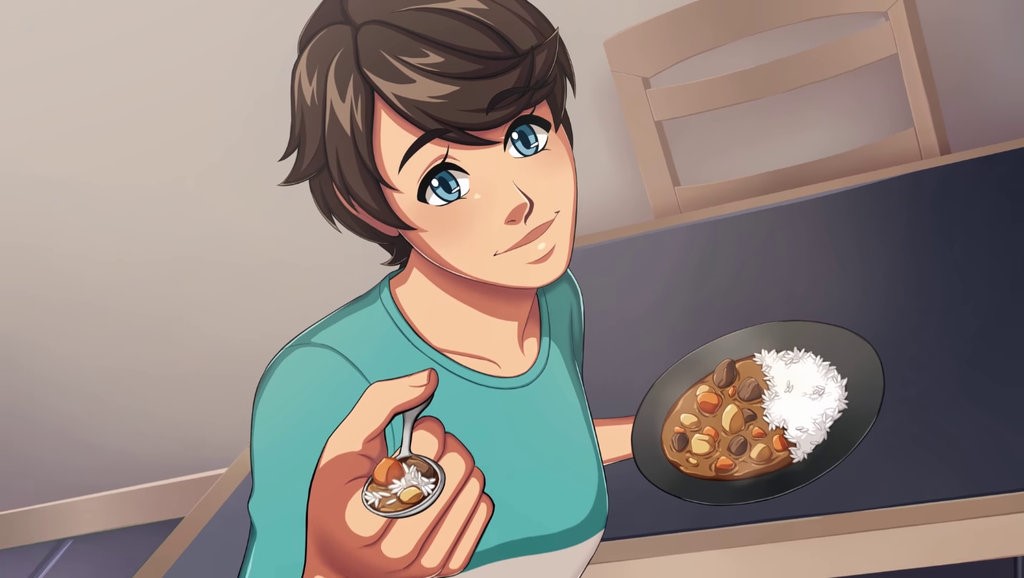
Tomboys Need Love Too!
PLK: In Tomboys Need Love Too! and many of your commissioned works you wrote erotic scenes, but they’re very visibly absent in Sable’s Grimoire. We all know that sex sells and monster-girl sex especially so – weren’t you tempted to include fanservice and h-scenes to boost sales?
Z: I was definitely tempted to add sex scenes, or at least erotic scenes. As you've noted, many of the games I've worked on include sex scenes, and I'm not about to stop making games with such content either. Be that as it may, I don't consider sexual content to be a requirement for a visual novel, and above all, I don't want to force it into a game if I think it isn't a good fit, or that it might detract from the story.
I went into Sable's Grimoire undecided as to whether any would be included or not. Sable's Grimoire was never intended to be an eroge, nor was there any specific plot-related reason for sexual content to be included, so I decided to only include sex scenes if they fit the story, made sense for the route/character, and added something of value as opposed to being sex just for the sake of it. There were a couple of points where I thought it could potentially be made into a worthwhile addition. I spent far more time than you'd think mulling over whether to add them or not, what ramifications they would have for the current route and others, whether doing so would really improve their routes, how it would affect characters' relationships, and many other things.
Ultimately, I decided that it didn't fit my vision of what Sable's Grimoire should be. I didn't want to cram in sex scenes when they made no sense, or warp character routes/personalities until it did fit in. I was happy with how the story played out without sexual content, and I didn't feel that it would be improved by adding it in. So I chose to leave it out, knowing full well that I'd be losing sales by doing so.
I went into Sable's Grimoire undecided as to whether any would be included or not. Sable's Grimoire was never intended to be an eroge, nor was there any specific plot-related reason for sexual content to be included, so I decided to only include sex scenes if they fit the story, made sense for the route/character, and added something of value as opposed to being sex just for the sake of it. There were a couple of points where I thought it could potentially be made into a worthwhile addition. I spent far more time than you'd think mulling over whether to add them or not, what ramifications they would have for the current route and others, whether doing so would really improve their routes, how it would affect characters' relationships, and many other things.
Ultimately, I decided that it didn't fit my vision of what Sable's Grimoire should be. I didn't want to cram in sex scenes when they made no sense, or warp character routes/personalities until it did fit in. I was happy with how the story played out without sexual content, and I didn't feel that it would be improved by adding it in. So I chose to leave it out, knowing full well that I'd be losing sales by doing so.
PLK: Let’s talk a bit about the game’s story. Like I’ve already mentioned, you use the monster-girl theme in a rather unusual way and by itself, it’s quite a departure from the more realistic settings of your other VNs. What drew you towards fantasy and the “magic academy” setting?
Z: My other games have been based in more realistic settings, but that isn't necessarily my preference. I have many ideas for games jotted down which range from completely realistic to outright fantasy. Still, I think my main reason for undergoing such a big shift all of a sudden would be my desire for a bit of variety. When I finished Sickness, I didn't want to write something else that was long, or dark, or with lots of branching. That desire to do something completely different led to the creation of Tomboys Need Love Too.
Similarly, after finishing TNLT, I wanted to make something longer, with more choices and a bigger cast. I wasn't necessarily aiming for a fantasy game, but with both Sickness and TNLT having real-world settings, something less grounded in reality did seem appealing. Writing the same kind of content for every one of my VNs would probably give players a better idea of what to expect from me, but it would be more boring for me as the one making them. Variety is what keeps me interested, and while my games will have common themes, I'll gladly do something completely different if it sparks my interest.
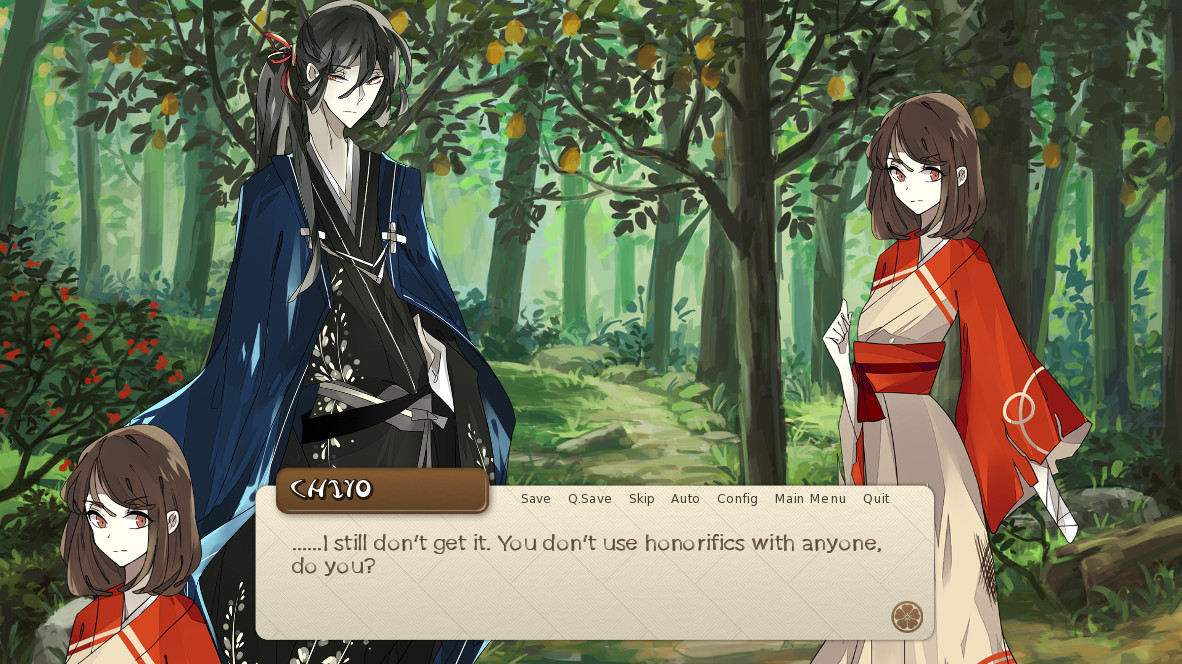
Wander No More
PLK: One of the things that quickly got my attention while playing SG is how disinterested in romance Sable is and how much his attitude influences the routes. Weren’t you worried that people will be disappointed by that in a game which, at first glance, might look like a typical waifu VN?
Z: It's definitely a concern of mine. I understand that anyone glancing at a cast of monster girls and seeing the academy setting is probably going to just assume it's that kind of game. I've made it clear in discussions about the game that there's no 18+ patch, no sex, etc. I've also steered clear of terms like "dating sim", and tried to focus more on other aspects of the game.
Even so, the unfortunate reality is that players will still walk into SG with that kind of expectation. Connections of "monster girls = hentai", "academy setting = sex with schoolgirl waifu" and so on are deeply rooted in the medium, and it's not one that I see being broken any time soon.
I've also done myself no favors by having a mostly female cast, or including light elements of romance and showing screenshots to that effect. Sable's Grimoire is about friendship more so than romance, but I couldn't fault anyone for assuming otherwise. At this point, I can only hope that anyone who walks in with those expectations will give the game a fair go, and be pleasantly surprised by what they do find instead. Sable's Grimoire may not match their preconceived notions of what this kind of visual novel will contain, but I'd like to think that they will enjoy it nonetheless.
PLK: Routes in Sable’s Grimoire are very distinct from each other when it goes to climate and themes. Is there one you’re especially proud of or one you particularly enjoyed writing?
Z: That's a tough one. All of the routes appeal to me in different ways, and I hope that diversity is something players enjoy. But it does make picking a favorite a difficult choice for me. If I had to pick, I'd say Drakan's route was my favorite. It's hard to elaborate without spoilers, but I will say that I enjoyed the (sometimes unexpected) disconnect between humans and dragons, and the occasional reminder that our prideful protagonist Sable isn't quite as special as he thinks.
Most of the characters display differences of one variety or another to human beings. It could be their culture, what they consider to be "common sense", or just a matter of biology. I enjoyed exploring the stark contrast between a dragon - nigh-omnipotent, wise, immune to the ravages of time, a predator to other demi-humans - and a plain old human being.
PLK: You've created an impressive, detailed world for this project, with many interesting characters and stories that were signalized, but never elaborated upon. Are we going to see more games in this universe?
Z: It's something I definitely want to do. I wrote at length about this on Steam in the Sable's Grimoire discussion board. To summarize my rambling over there, I do want to create new games in the same world as Sable's Grimoire, and any expansions would likely be in the form of spin-offs for individual routes (a direct sequel is difficult, given the branching).
Ultimately, it will depend on SG's reception. I already have ideas for spin-offs and ways to expand SG, but whether those ideas actually become games or not will depend on SG's sales. I've toyed with the idea of crowdfunding such expansions. It would be a good way to gauge interest before committing to anything. But for now, I'm going to focus on other things. Once SG has been out for a while I'll be taking another look at how well it's been received and whether additional games would be viable or not.
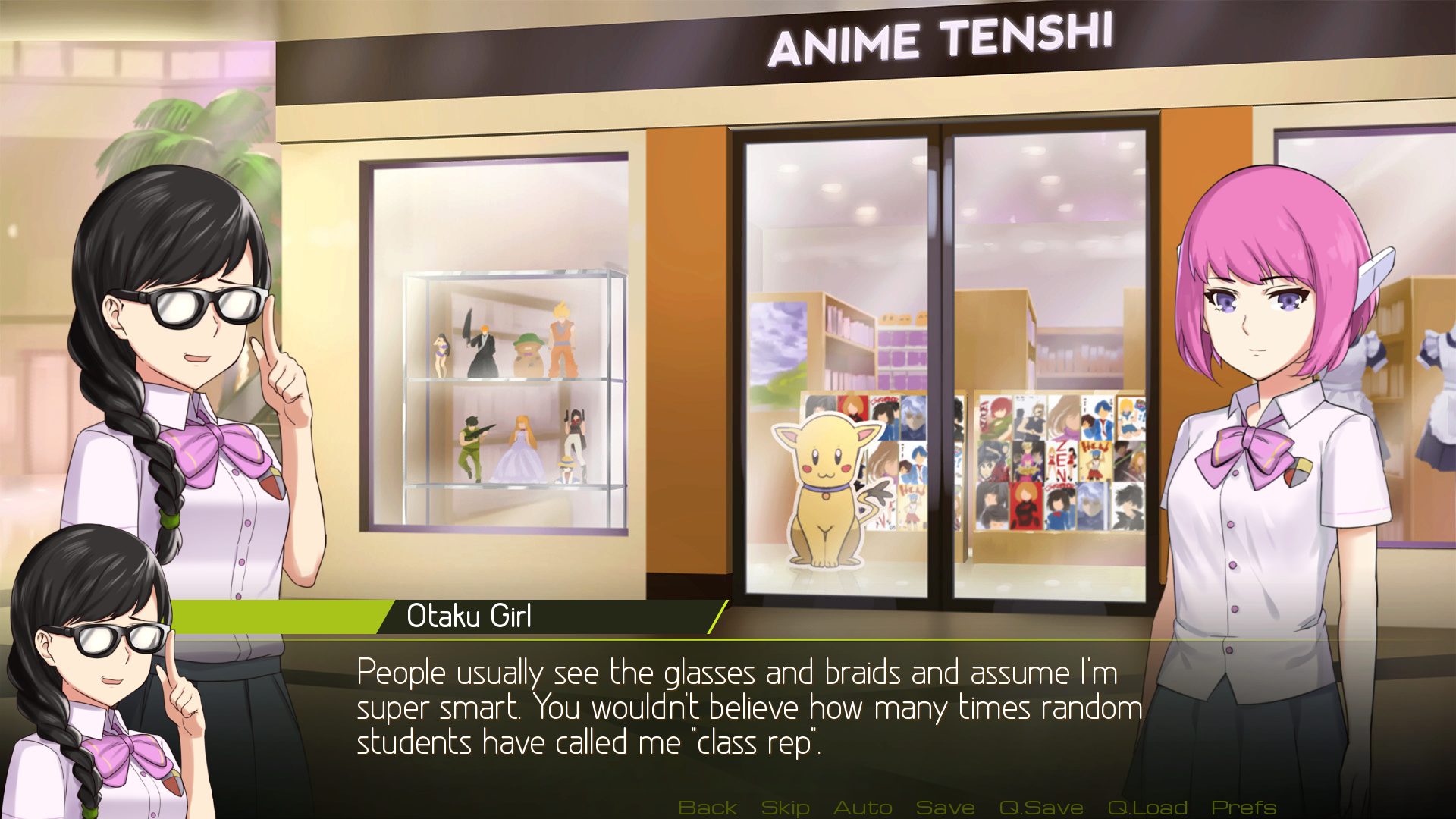
Humanity Must Perish
PLK: Sooo... Meara’s route? ;)
Z: I was actually leaning towards adding a route for Meara while implementing Jorou's recently released additional ending. I ultimately chose to focus on what I was doing and not get side-tracked, but the notion is still firmly planted in my mind.
For the time being, I'm working on Tix's route, since that's the one players keep asking about, but after that I'll be considering new content to add. So new content for Meara is certainly on the table, but not in the near future.
PLK: Beyond Sable's Grimoire and its universe, are there any other projects you're working on? Is there anything you could tell us about those?
Z: They're both a fair way off being complete, so it's probably a bit too early to give much detail on them, but there are two more games I've started work on. If all goes well, I expect both of them to be finished in 2019. The first game is My Heart Grows Fonder. It tells the story of a jilted young office worker whose girlfriend suddenly disappeared without saying a word, only to show up on his doorstep years later expecting everything to go back to how it was before. He insists that he's moved on, and that the two of them are through, but as the former couple spend time together, it becomes clear that it isn't that simple. The themes are similar to those in Tomboys Need Love Too, but with an older cast and a slightly more mature take on things. There will be two love interests and a free H patch. It should be a bit longer than TNLT, maybe 1.5x the length.
The second game is called Circadian Loop. It takes place in a real-world setting with mild supernatural elements, set in the same universe as Sickness. This game follows the life of a young boy who has been torn away from his family, and is now being raised by an out-of-touch businessman who has some rather warped views on the world. The boy grows up, molded by this new environment, to become a shrewd, charismatic entrepreneur, assisted by a mysterious power he keeps secret even from those closest to him. This game will contain violence and a few somewhat scary scenes. I don't think it will be anywhere near as violent as Sickness though. A fair portion of the game focuses on the main character's growth during his teen years. It then changes track a bit once he reaches adulthood. A lot of this is subject to change, as Circadian Loop is still in the early stages of development.
I'm expecting My Heart Grows Fonder to be released Q1 2019. It's harder to estimate with Circadian Loop, but for the time being, I'll say Q4 2019.
PLK: Beyond Sable's Grimoire and its universe, are there any other projects you're working on? Is there anything you could tell us about those?
Z: They're both a fair way off being complete, so it's probably a bit too early to give much detail on them, but there are two more games I've started work on. If all goes well, I expect both of them to be finished in 2019. The first game is My Heart Grows Fonder. It tells the story of a jilted young office worker whose girlfriend suddenly disappeared without saying a word, only to show up on his doorstep years later expecting everything to go back to how it was before. He insists that he's moved on, and that the two of them are through, but as the former couple spend time together, it becomes clear that it isn't that simple. The themes are similar to those in Tomboys Need Love Too, but with an older cast and a slightly more mature take on things. There will be two love interests and a free H patch. It should be a bit longer than TNLT, maybe 1.5x the length.
The second game is called Circadian Loop. It takes place in a real-world setting with mild supernatural elements, set in the same universe as Sickness. This game follows the life of a young boy who has been torn away from his family, and is now being raised by an out-of-touch businessman who has some rather warped views on the world. The boy grows up, molded by this new environment, to become a shrewd, charismatic entrepreneur, assisted by a mysterious power he keeps secret even from those closest to him. This game will contain violence and a few somewhat scary scenes. I don't think it will be anywhere near as violent as Sickness though. A fair portion of the game focuses on the main character's growth during his teen years. It then changes track a bit once he reaches adulthood. A lot of this is subject to change, as Circadian Loop is still in the early stages of development.
I'm expecting My Heart Grows Fonder to be released Q1 2019. It's harder to estimate with Circadian Loop, but for the time being, I'll say Q4 2019.
PLK: Thank you for your time!

